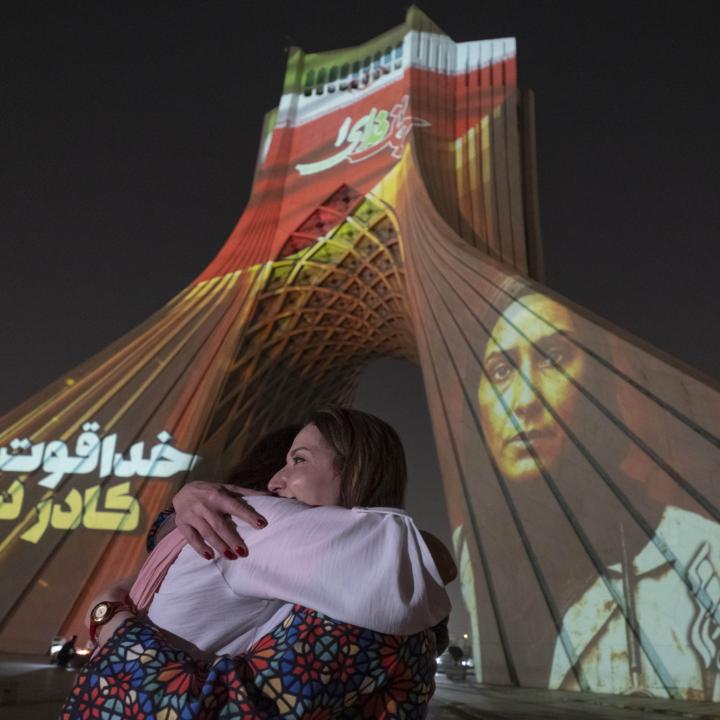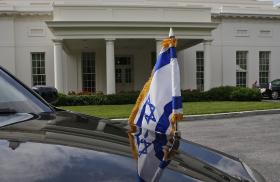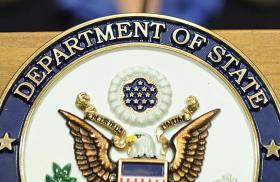
- Policy Analysis
- PolicyWatch 4073
Iran on Day 13: Gauging Regime Choices and Public Attitudes After the War

Two human rights experts discuss the chances that Iran’s domestic crackdown will escalate under the ceasefire, while a former CIA manager explains why the clock is rapidly ticking away on key elements needed to effectively monitor the damaged nuclear program.
On July 2, The Washington Institute held a virtual Policy Forum with Holly Dagres, Roya Boroumand, and Norman Roule. Dagres is the Institute’s Libitzky Family Senior Fellow and curator of The Iranist newsletter. Boroumand is cofounder and executive director of the Abdorrahman Boroumand Center for Human Rights in Iran. Roule, a nonresident senior advisor with the Center for Strategic and International Studies, formerly served as the CIA’s National Intelligence Manager for Iran. The following is a rapporteur’s summary of their remarks.
Holly Dagres
The war has left Iranians shaken, and many are skeptical that the ceasefire will hold. In Tehran specifically, people are coming together—not to rally around the flag of the Islamic Republic, but because they are Iranian, have a shared experience of war, and are having to pick up the pieces together.
In general, the public mood during the war and its aftermath has been anger. Much of this sentiment has been directed at the Islamic Republic for not providing shelters and air raid sirens. People are also angry that officials have brought the country to this moment through their decisionmaking, such as funding foreign militia proxies, promoting the mantras of “death to Israel and America,” and advancing the nuclear program.
In addition, some Iranians are frustrated with the United States and Israel for not going after the Supreme Leader and other top political figures, since this means the regime will survive and will now go after its people. Many analysts have focused on President Trump’s tweet mentioning regime change, but a lot of the social media messaging from the Israeli government expressed this sentiment as well. The targeting of the Basij headquarters, the entrance to Evin Prison, and state media organs also played into this rhetoric.
Yet many Iranians recognize that no foreign power is going to save them from the Islamic Republic, and they do not want such changes to come at the cost of bloodshed and war. The latest military hostilities exposed the growing weakness of the regime, and some Iranians believe it is well on its way to internal collapse. Unfortunately, however, Tehran appears to be doubling down, not just in its rhetoric against Israel and the United States, but also in its repression of the people. Many Iranians—from activists to ordinary citizens—have expressed their fear that the Islamic Republic will direct its revenge at them rather than abroad. This is already playing out with more than 1,500 arrests and numerous executions since the war broke out.
Analysis of potential regime collapse in Iran should focus on defections. At this juncture, the security forces have continued to mobilize and establish checkpoints throughout the country. Another factor to watch is widespread shortages of food, fuel, or basic goods; no such shortages have been reported so far. No mass anti-regime protests have been noted either, though celebrations on social media were evident throughout the war, along with anti-regime chants issued from rooftops and windows. Historically, protests in Iran have been prompted by an array of issues, and they could put the regime at risk of collapse under certain circumstances. None of these signs has materialized yet, but that could change quickly. In the post-October 7 world, past assumptions about the region do not carry the same weight they once did, as evident in the maiming of Hezbollah, the latest military showdown with Iran, and the fall of Bashar al-Assad’s regime in Syria.
Roya Boroumand
The most relevant historical parallel to the current moment is the end of the Iran-Iraq War. In the summer of 1988, Iran reached a ceasefire with Iraq and accepted UN Security Council Resolution 598. For Ayatollah Ruhollah Khomeini, this was a humiliating defeat—assenting to the UN resolution was tantamount to admitting failure, since the regime had imposed six additional years of hardship on Iranians despite winning back its territory in 1982, just two years into the long war.
At the time, Iranian jails were filled with thousands of political prisoners, including many members of Mujahedin-e Khalq (MEK) and other dissident groups. The regime had already separated “repentant” and “unrepentant” prisoners, and it was concerned that releasing the latter into society would enable them to organize dissent more broadly. In July 1988, MEK forces entered Iran from bases in Iraq, triggering intense prison unrest. In response, between 4,000 and 5,000 political prisoners were secretly hanged. Since then, the intelligence ministry has devoted enormous effort to preventing and undermining all dissident groups inside and outside Iran, using imprisonment, extrajudicial killings, forced disappearances, and other tactics to keep people from organizing.
After the latest war, many are rightfully worried that the Islamic Republic will launch an increasingly punitive policy at home. The state has long been harsh on Iranians who post unfavorable content on social media, but the consequences going forward will be more serious than they were during the 2022 “Woman, Life, Freedom” uprising. At least seventeen people have already been executed. There is no due process in such cases, and no lawyers are present during interrogations; for many prisoners, their lawyers do not appear until the last session of the trial. Coerced confessions are common, as is the use of torture. The Iranian intelligence apparatus does not have to provide evidence to people who are convicted or their lawyers. This is especially concerning because authorities have announced more than a thousand arrests during the current crisis—a figure that does not include arrests in Tehran or unannounced detentions.
Minorities in particular are terrified now that the ceasefire is in place because they are more at risk—the Kurds more than anyone else. The Islamic Republic is probably not in a position to carry out mass executions today given the prevalence of information technology. Yet it is also a weak, humiliated, and paranoid regime that has just survived an incredibly effective attack and is now trying to reassert its authority by turning its wrath on the Iranian people. The severity of that wrath will partly depend on how much attention the international community pays to this persecution, since the regime is still concerned about its image regardless of what it may say to the contrary.
Norman Roule
Iran’s current actions are the culmination of a trend that began in 2018 as its relationship with the International Atomic Energy Agency eroded. Since then, multiple IAEA statements have noted the regime’s increasing noncompliance, and Tehran has responded to each of these statements by expanding its nuclear program. The international community did nothing about this, demonstrating that red lines could be disregarded—until now.
If IAEA inspectors reentered Iran today, they would no doubt conclude that the nuclear program has suffered a devastating blow, and that Iranian security officials have denied this reality because they do not want to admit what Israel and the United States have achieved. Crucially, the international community does not want the IAEA to declare Iran in breach of the Nuclear Nonproliferation Treaty, since that could provoke the regime to withdraw from the treaty and significantly erode the entire NPT structure (the only country to withdraw in the past is North Korea). Iran therefore has some leverage over the international community and may use it to extract concessions from Europe and the United States. To counter this leverage, the IAEA needs to be a reliable actor and demonstrate that member states cannot brazenly defy the world’s top nuclear watchdog.
The timeframe for nuclear negotiations is much more compressed now. In October, Russia assumes the rotating presidency of the UN Security Council and will surely obstruct efforts to pressure Iran and reach a viable diplomatic outcome. Therefore, Europe and the United States may push to “snap back” UN sanctions before then. In doing so, they will have to rely primarily on their own intelligence information to keep abreast of what Iran does over the next few weeks, since the IAEA is no longer there. That is problematic—not because U.S. or partner intelligence is wrong, but because the IAEA is seen as a fair voice in the international community and is therefore necessary to bring the rest of the world along.
Iran will also be taking a hard look at its air defenses, since Israel and the United States controlled its airspace with ease. Regime officials will likely engage Russia and China about acquiring more such systems, but obtaining and effectively fielding a new air defense network will be very difficult, expensive, and time-consuming. In the meantime, Tehran will likely focus on what military lessons it should learn from the Israeli and American attacks, particularly those related to reorganizing, restoring, and protecting its missile launchers, air defenses, and other key systems. This is not just a matter of power projection against Israel, but also power projection against the Gulf and the United States. Right now, both are in question.
This summary was prepared by Manuel de la Puerta. The Policy Forum series is made possible through the generosity of the Florence and Robert Kaufman Family.





